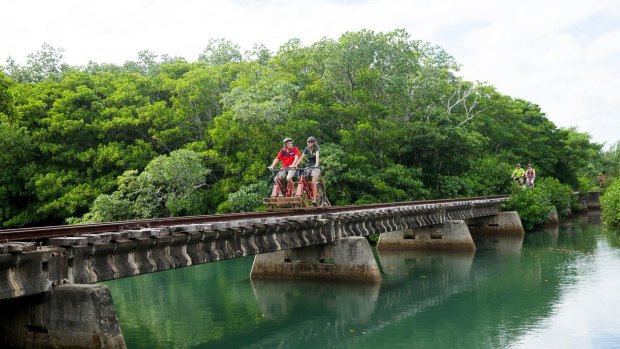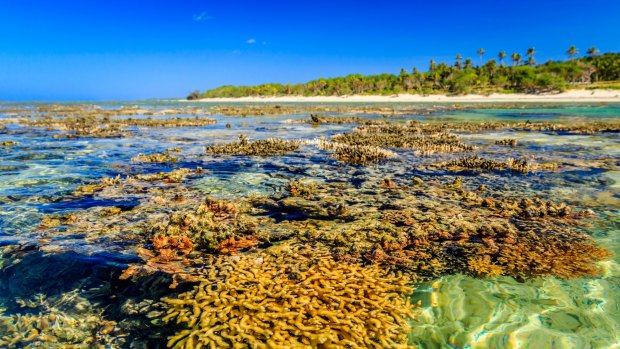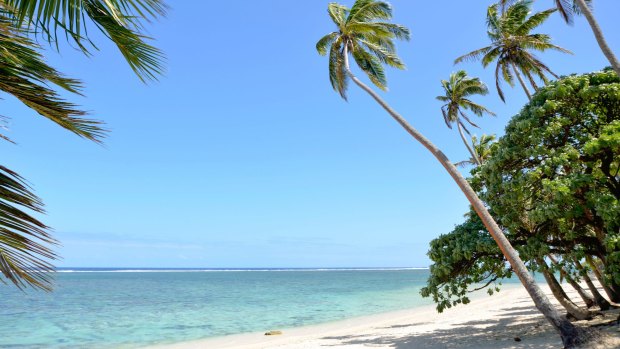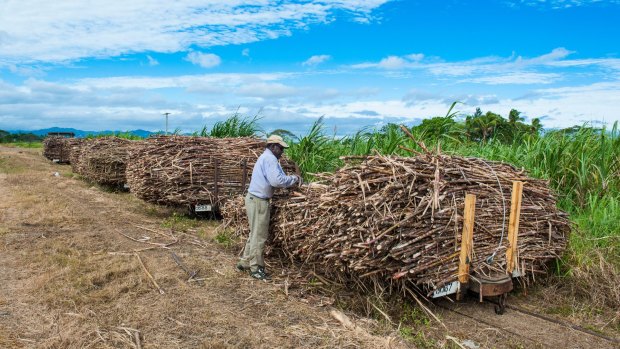This was published 5 years ago
Coral Coast, Eco Trax Fiji velocipede eco adventure: A unique way to see Fiji's sugar cane railway
By Steve Meacham

An Eco Trax velocipede being pedalled along Viti Levu's former sugar-cane railway line.Credit: Allan Stephen
We've had barely five minutes' instruction on how to control our "velocipede" and yet here we are, cruising at almost 20 kilometres an hour through the lush vegetation of Fiji's Coral Coast. We've been told 20 km/h is the vehicle's maximum speed and my much younger journalist colleague (aka Brakewoman) is determined we stay at exactly 19.95 km/h, no matter how hard I pedal. On the return journey, however, that mysteriously increases to 25 km/h.
We are on a Fijian odyssey like no other. We have just three hours to complete the equivalent of a half marathon to reach and return from our destination, Vunabua (aka Frangipani Beach). There, we take a relaxing dip in lukewarm Fijian waters, replenish ourselves with fresh coconut milk, pineapple and banana, and ready ourselves for the return journey. We deserve it. On the outward journey, we experienced many fearsome obstacles.
A big black butterfly almost crashed into Brakewoman, causing her to … well, brake, violently. A low-hanging papaya might have done shocking damage to my cycle helmet, if I hadn't ducked. And a particularly obstinate young goat had refused to leave the rail track. ("Hey kid, don't you realise this is a velocipede?")

One of the many reefs along Fiji's Coral Coast. Credit: Alamy
Eco Trax Fiji is billed as the world's first, eco-friendly velocipede adventure. The word "velocipede" - which I'd never heard before - was introduced in our pre-adventure briefing. According to my research, you'll have mastered the velocipede if you've ever ridden a bicycle.
The first velocipede (Latin for "swift" and "foot") was invented in France in 1817. Since then, variants have included the penny farthing, the boneshaker and the pushbike. Around the 1870s, the Americans patented the name velocipede as a single bike with an outlying wheel that could be propelled along railway tracks, allowing engineers to get to and from the railhead.
Now, Fiji has re-imagined the concept, creating a (solar-powered) battery-assisted, pedal-propelled "tandem" mounted on a lightweight rail buggy. Brakewoman and I were the first overseas journalists to experience it.

The Coral Coast, on the island of Viti Levu, Fiji .Credit: Alamy
The genius behind Eco Trax Fiji is Howie de Vries, a self-described "Kiwi train geek" who saw an opportunity when Fiji's sugar cane railway was closed in 2010. "Howie realised this was a great piece of Fijian history that was going to waste," says Mandy Heron, his wife and business partner. "So he re-invented the velocipede. And we got a 10-year lease on this 11.2-kilometre section of the sugar-cane railway on the Coral Coast, near the Shangri-La resort."
Each velocipede can carry a third person, usually a child, although the oldest passenger since Eco Trax opened in September 2017 was 97.
We stop many times on the outward journey (not always Brakewoman's fault) because our guide, Brittany, points out so many things of interest. There's the hill fortress where one tribe defended itself against its neighbours, knowing (if it came to a battle) the vanquished would be eaten. We see herds of horses, left to roam wild until reclaimed by their owners. Mongoose dart over the lines, imported from India to keep the cane fields free of rats and snakes.

Fiji's sugar cane trains as they used to look.Credit: Alamy
We "cycle" through two villages, shouting "bula!" to the adults and schoolchildren who are happy to greet us – and across eight rickety Indiana Jones-like bridges (don't worry, they've been tested). As Brittany tells us, "This is a trip through real Fiji, away from the resorts. This is how village people live."
She's right. These modern velocipedes are virtually silent, and the track weaves its way between ocean and Fijian civilisation as it was – and still is. How sweet this redundant sugar cane railway has become.
Steve Meacham travelled a guest of Fiji Airways and Eco Trax Fiji.
TRIP NOTES
MORE
FLY
Fijian Airways flies to Nadi International airport from Sydney, Brisbane, Melbourne and Adelaide. See www.fijiairways.com
CYCLE
Eco Trax Fiji, Cuvu, Singatoka, Western, Fiji. ecotraxfiji.com
See also: The best time to visit Fiji
Sign up for the Traveller Deals newsletter
Get exclusive travel deals delivered straight to your inbox. Sign up now.